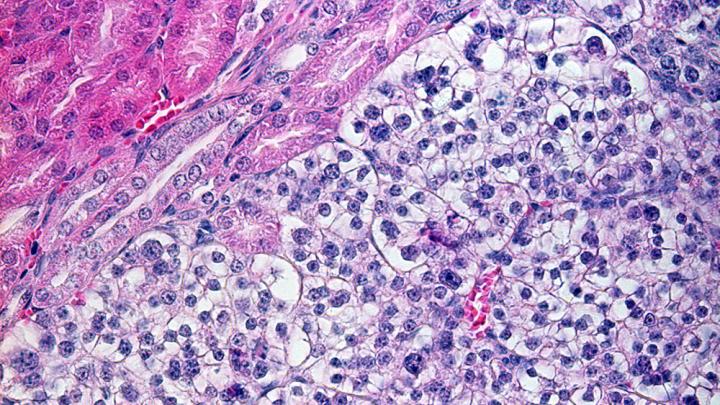![UZH researchers were able to develop a mouse model for kidney cancer for the first time. [University of Zurich]](https://genengnews.com/wp-content/uploads/2018/08/May31_2017_UnivZurich_MouseModelKidneyCancer2516114812-1.jpg)
UZH researchers were able to develop a mouse model for kidney cancer for the first time. [University of Zurich]
Researchers at the University of Zurich say they have developed a mouse model of renal cell carcinoma, the most common form of kidney cancer. The study was led by Sabine Harlander, Ph.D., and her colleagues at the Institute of Physiology of the University of Zurich in the lab of Ian Frew, Ph.D., who recently joined the University of Freiburg in Germany. The researchers began by identifying the genes that often mutate in human renal cell carcinomas. They then mutated three of these genes simultaneously in renal cells of mice, which then developed renal cancer.
The team published its study (“Combined Mutation in Vhl, Trp53 and Rb1 Causes Clear Cell Renal Cell Carcinoma in Mice”) in Nature Medicine.
The progression from gene mutation in the renal cells to the development of a tumor took 8 to 12 months. This lengthy period of time, compared to a mouse's lifetime, indicates that additional factors play a role in tumor development. The researchers therefore decided to take a closer look at the protein-encoding genes in the mouse tumors. They discovered that in all of the tumors at least one of the many genes responsible for the correct functioning of the primary cilium, a hair-like structure found on the cell's surface and responsible for coordinating cell signaling, had mutated.
Based on this finding, the researchers discovered that similar mutations also occur in renal cell carcinomas in humans. The scientists now believe that the loss of normal function in the primary cilium leads to the uncontrollable division of renal epithelial cells, which contributes to the formation of clear cell renal cell carcinoma (ccRCC). “This research project is a prime example of how mouse models can help us to better understand cancer diseases in human beings,” says Dr. Harlander, who adds that this new mouse model will make it possible to develop better therapies for renal cancer.
For example, in the case of patients with renal carcinoma metastasis who are given different medications, some patients respond to the medications, while others do not. The same phenomenon can be observed when mice with renal cancer are treated with the same drugs as the humans. Some tumors shrink, while others do not. Now researchers can investigate the factors that contribute to why certain tumors respond to certain medications and not to others.
“We hope that our mouse model, which allows us to combine drug testing and genetic analysis, will provide a deeper understanding of why tumors are sensitive or resistant to drugs,” notes Dr. Frew. “Such vital information could be used to better adjust treatments to the characteristics of each patient.”
The mouse model could also contribute to the further development of immunotherapies, according to the investigators. In the last few years, much progress has been made in this field of cancer research, including for the treatment of renal cell carcinomas. Now, it should be possible to study how renal tumors are able to develop in an environment with a normal immune system, and how cancer cells manage to evade the immune system's attacks. Ultimately, the researchers' goal is to use these new findings to improve the effectiveness of immunomodulatory treatments.






